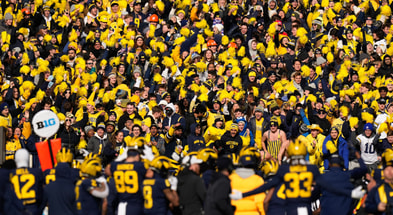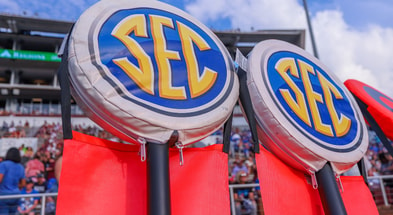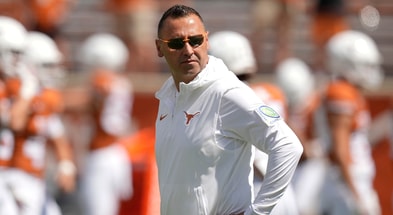Ruminations on the last year of the four-team College Football Playoff
The 2023 college football season is one of several firsts and nearly as many lasts. It’s the first year for Houston, BYU, Cincinnati, and Central Florida in the Big 12. Several other Group of 5 schools are entering a new conference, and some are even joining the Football Bowl Subdivision ranks (Hello, Sam Houston State!).
[Join Inside Texas today and get the best Texas Longhorns insider team info and recruiting intel!]
It’s the last year for Texas and Oklahoma in the Big 12. Similar applies for USC and UCLA in the Pac 12. The Longhorns and Sooners are SEC bound next July, while the Trojans and Bruins join the Big 10 beginning next summer.
Those changes have been major topics of discussion throughout the offseason not just in Austin, but across the college football landscape.
There’s another significant change ahead for college football that arrives following the 2023 campaign. For the 2024 and 2025 seasons, the final two years of the College Football Playoff’s contract with the 10 FBS conferences and Notre Dame, the CFP will feature 12 teams. The first round will consist of on-campus home games for seeds 5-8, while the four highest-rated conference champions will earn byes into the quarterfinal round beginning next year.
Until then, the CFP will have four teams just as it has since its inception in 2014. Texas has aspirations to win the Big 12 in 2023, and if it’s able to do so it’ll realistically enter the conversation for the four-team playoff for the first time in the format’s history.
The season will determine whether Texas and its fans will need to pay attention to the CFP ranking reveals on Tuesday nights in November. That, of course, is a micro issue (if one can call Texas and its coverage micro). There are a number of macro points of discussion when it comes to not only the Longhorns, but also FBS football on the whole entering the last scheduled year of the four-team playoff. Macro points like…
Perfection de-emphasized
The following is a list of teams who have won consensus national championships with more than one loss since the end of World War II.
- 1960: Minnesota
- 2007: LSU
The 1960 Golden Gophers fell to Purdue in the regular season, but that was their only blemish ahead of their end-of-year coronation. They eventually lost the Rose Bowl, but their champion status had already been decided.
2007 LSU is unique as the only two-loss team since the BCS era began to take home the national title. Famously ”undefeated in regulation,” LSU’s two defeats were triple-overtime losses. Les Miles’ Tigers won the SEC title then defeated Ohio State in the national championship game. They are the most recent team with more than one loss to even contend for a national championship, let alone win one.
College football has had a unique emphasis on perfection no other sport’s regular season can replicate. Consider that only two teams since the AFL/NFL merger have completed undefeated regular seasons. In other major sports, college or pro, faultless or near-faultless seasons are beyond reasonable expectation.
But look at Texas’ four claimed national championships. Those four teams combined to lose one game.
It holds true to this day that the programs able to avoid any and all losses are championship contenders. College Football Playoff champions have combined for six total losses, with four teams recording undefeated seasons.
That won’t be a requirement when the 12-team playoff comes into existence. Teams could lose two games, and potentially even three, and still make the playoff field. Those teams will be worthy contenders because even two-loss teams are products of high-quality programs. But those teams won’t be approaching perfection like champions of recent memory.
Is that a bad thing? Any team who, for the purposes of this exercise, makes the Playoff at 9-3 would still have to
- defeat a top eight team on the road in December
- win a neutral site game against a conference champion coming off a bye
- win the national championship game against an equally beleaguered and equally matched opponent.
A team who does that is a worthy champion. But, they wouldn’t be a perfect champion like so many title winners before them.
It’s not a bad thing. The expansion of the Playoff does provide a path to postseason play for more than just the tippy-top of the power conferences. But it does mean something college football has had for over a century — an emphasis on perfect or near-perfect seasons — could be lost (at least for 2024 and 2025). Knowing how the sport operates though, the format will likely carry over into the next era of college football.
A Big 12 championship is (usually) good enough
During the Playoff era, every Big 12 champion with one or fewer losses save for 2014 TCU made the CFP’s field of four. Now, “every Big 12 champion” in this sense means Oklahoma, who made the Playoff in 2015, 2017, 2018, and 2019. TCU missed the CFP in 2014 during the ‘One True Champion’ debacle. They were, however, selected in 2022 as the No. 3 seed after an overtime loss in the Big 12 Championship game to Kansas State. That, of course, was their only loss of the 2022 regular season.
That’s all to say that since the CFP demands perfection or near perfection for another year, a Big 12 champion with one loss is a near-lock to make the College Football Playoff.
That is the needle Texas is trying to thread in 2023.
It’s worth noting several of those Oklahoma playoff teams had solid to excellent non-conference wins. 2015 Oklahoma beat a ranked Tennessee team in Knoxville. The 2017 Sooner team beat No. 2 Ohio State in the Horseshoe at night, a feat that usually bodes well for Big 12 teams. 2018 OU defeated a bad UCLA squad but scored so many points during the year that it didn’t matter. 2019 OU beat Houston, South Dakota, and UCLA with another explosive offense.
TCU, like previous Oklahoma teams, rode an explosive offense led by a Heisman finalist to the Playoff last season.
The Longhorns’ non-conference schedule this season features paltry Rice, lowly Wyoming, and… a game at Alabama. If Texas goes undefeated against that slate and then suffers only one Big 12 loss on the way to a conference title, or if the Longhorns are perfect in Big 12 play after a close defeat against the Crimson Tide in Tuscaloosa, the Playoff won’t be a certainty but it’ll be as close as one can get.
Excellence is necessary and sufficient for a Big 12 team to make the current iteration of the CFP. Texas’ version of necessary and sufficient, should it come to be in 2023, would be in the that category.
A look at the 12-team future
What if the 12-team playoff were around in 2022?
Three SEC: Georgia, Alabama, Tennessee
Three Big 10: Michigan, Ohio State, Penn State
Two Big 12: TCU, KSU
One ACC: Clemson
Three Pac-12: Utah, USC, Washington
In 2021, three SEC teams were in the final 12. Four SEC teams were in the top 12 in 2020. Same goes for 2019 and 2018. Only three SEC teams made the top 12 in 2017, but two of those three ended up in the championship game.
How the committee views things going forward with a 16-team SEC that includes Texas and Oklahoma remains to be seen. Similar can be said for the Big 10 once USC and UCLA arrive. To date, SEC representation is consistent but teams from Texas’ future conference haven’t made up an exorbitant percentage of the top 12 in recent years.
With that in mind, there isn’t much reason to believe an 8-4 SEC team is going to make the field of 12 in 2024 just because it played in the SEC. It’s tough for a three-loss team to make the final 12. Only two programs, K-State and Utah, did so in 2022 and that’s because they were 10-3 Power 5 conference champions.
Maybe the committee does value a 9-3 Florida team over an 11-2 Washington who lost in a hypothetical Pac-12 title game to a plucky upstart Oregon State that arrived in Las Vegas out of the playoff picture.
There’s no way of knowing that for sure until the calendar turns to 2024. The best way to avoid being on college football’s newfound bubble next year and any year? Win. That, in a sport constantly in flux, is never going to change, and never will.
























